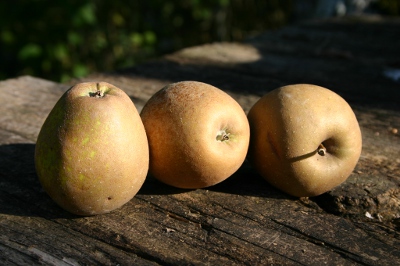︎︎︎ MELA PERA

La buccia è spessa, con colore di base giallo, ma coperta diffusamente di ruggine. La polpa è bianca, acidula, aromatica e croccante. In generale è un frutto di buona qualità anche se piccolo e poco appariscente. Viene raccolta tradizionalmente in ottobre e si conserva in fruttaio fino alla primavera successiva, senza grandi trasformazioni. La mela Pera era preziosa in passato per la sua serbevolezza. E’ adatta al consumo fresco, soprattutto durante l’inverno. Il suo nome è dovuto alla forma che la fa somigliare ad una pera, ma anche per la sua rugginosità. Per la conservazione un tempo si usava anche legarle per i peduncoli e farne corone, da appendere in un luogo fresco e asciutto.
The mother plants were recovered in the area of Caprese Michelangelo (Arezzo), Pietralunga (Perugia) and in the Marche side of the Appennines. The origin of this variety is unknown. A few scattered specimens were found in southern Umbria. The tree is very vigorous and hardy, with spreading crown; it crops on alternate years and blooms late in the season. The fruit It is medium-small, oblong in shape with a typical tapering towards the calyx. The stem is medium in length and inserted in a wide, moderately deep cavity while the calyx is almost absent. The skin is thick, of yellow colour covered with widespread russeting. The flesh is white, slightly sour, aromatic and crisp. In general it is a good quality fruit even though small and not aesthetically striking. It is traditionally harvested in October and stores well in the fruit-house until the following spring. In the past the pera apple was rather valued for its storing capacity. It is suitable for fresh eating especially in the winter. Its name comes from its pear-like shape but also from its russeting. These apples used to be stored by being tied by their stems to a stiff twine in the shape of a crown and the ring would be hung up in a cool and dry place.